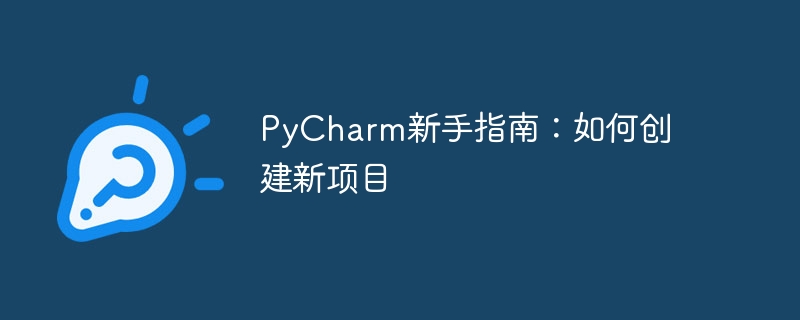Home >Backend Development >Python Tutorial >PyCharm Beginner's Guide: How to Create a New Project
PyCharm Beginner's Guide: How to Create a New Project
- WBOYWBOYWBOYWBOYWBOYWBOYWBOYWBOYWBOYWBOYWBOYWBOYWBOriginal
- 2024-02-22 18:12:041633browse

PyCharm is a powerful Python integrated development environment (IDE) that provides many convenient features to help developers write Python code quickly and efficiently. For beginners, it is very important to master the basic usage of PyCharm. This article will introduce how to create a new project in PyCharm for novice PyCharm users, and attach specific code examples.
Step One: Install PyCharm
First, you need to download the PyCharm installation package from the official website (https://www.jetbrains.com/pycharm/). Select the corresponding version according to your operating system, and then follow the prompts to install it step by step.
Step 2: Start PyCharm
After the installation is complete, double-click the PyCharm icon on the desktop to start the program. If it is the first time you start it, PyCharm will prompt you to select settings such as the interface language and install plug-ins. Just follow the wizard.
Step 3: Create a new project
In the PyCharm welcome interface, click the "Create New Project" button to create a new project. Then a dialog box will pop up, enter the name and save path of the project in the dialog box, and then click the "Create" button to create a new project.
Step 4: Set up the Python interpreter
When creating the project, PyCharm will ask you to select the Python interpreter. If you have installed Python, you can select the corresponding Python interpreter in the drop-down menu. If Python is not installed, you can click "New Environment" to install the Python interpreter.
Step 5: Write Python code
In the project structure on the left, you will see a folder named "src", which is where your Python code is stored. Right-click the "src" folder, select "New" -> "Python File" to create a new Python file, and then write your Python code in the file.
Next, we give a simple Python code example to output "Hello, PyCharm!" to the console:
def main():
print("Hello, PyCharm!")
if __name__ == "__main__":
main()After writing the code, you can click on the toolbar "Run" button to run the code, or use the shortcut "Shift F10" to run the code. You will see the output "Hello, PyCharm!" in the console.
Step 6: Save and submit the code
After writing the code, don’t forget to click “File” -> “Save” in the toolbar to save the code. At the same time, you can also use version control tools to submit code to the repository, which makes it easier to track code changes and manage projects.
Summary
Through the above steps, you have successfully created a new project in PyCharm and written simple Python code. I hope this PyCharm beginner's guide will be helpful to you and help you get started using PyCharm for Python development faster. Keep learning and exploring, and you will find that PyCharm is a very powerful and friendly development tool!
The above is the detailed content of PyCharm Beginner's Guide: How to Create a New Project. For more information, please follow other related articles on the PHP Chinese website!

